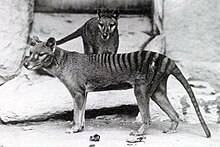Wp/nys/Noombat (Numbat)
| Ballardong | Noombat |
|---|---|
| English | Numbat |



The English name Numbat is derived from the Noongar name Noombat. Its scientific name is Myrmecobius fasciatus.
The Noombat is an insectivorous marsupial native to Western Australia and recently re-introduced to South Australia. Its diet consists almost exclusively of termites. Once widespread across southern Australia, its range is now restricted to several small colonies in Dryandra Woodland (150 km south-east of Perth) and the Upper Warren area (including Tone Perup Nature Reserve, Greater Kingston National Park and adjoining State Forest) (280 km south-south-east of Perth.[1][2]
Conservation status (WA): Endangered.[3][2] The Noombat is an emblem of Western Australia and protected by conservation programs.
Noombat is the closest living relative to the extinct top marsupial predator the Thylacine or 'Tasmanian Tiger', see the NoongarPedia article: Dwert (Dingo). They both have/had the same pattern of stripes (see picture).
Barna Mia ('home of animals') is an animal sanctuary in Dryandra Woodland. It is a place to discover threatened native marsupials like Noombat in a natural setting. A tour guide takes visitors on a journey through the sanctuary. Using special red spotlights, you can see threatened native animals such as bilbies, burrowing bettongs, rufous hare-wallabies, quendas, woylies and western barred bandicoots.[4][5]
See also
[edit | edit source]Ngearn waarnk
[edit | edit source]- ↑ 1.0 1.1 "Numbat (Myrmecobius fasciatus) Recovery Plan". Western Australia Department of Parks and Wildlife. Published September 2015. p 5. Retrieved 27 January 2019
- ↑ 2.0 2.1 "Upper Warren - home of threatened fauna". Dept. of Biodiversity, Conservation and Attractions. Govt. of WA. Retrieved 28 January 2019
- ↑ “Numbat”. IUCN Red List of Threatened Species. Retrieved 1 February 2019
- ↑ "Barna Mia Nocturnal Wildlife Experience". Parks and Wildlife Service. Govt. of WA. Retrieved 10 February 2019
- ↑ "Barna Mia Nocturnal Animal Sanctuary" pdf. Department of Parks and Wildlife. Govt. of WA. Retrieved 10 February 2019
- ↑ "Numbat Myrmecobius fasciatus". Fauna Profile. Dept. of Biodiversity, Conservation and Attractions. Govt. of WA. Retrieved 28 January 2019
